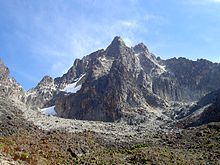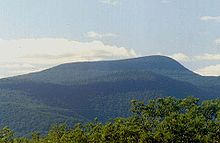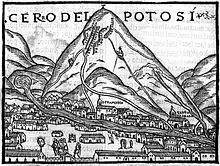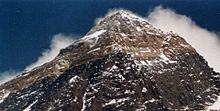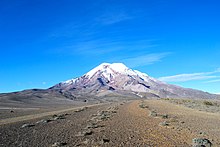From Wikipedia, the free encyclopedia
A
seamount is a
mountain rising from the
ocean seafloor that does not reach to the water's surface (
sea level), and thus is not an
island,
islet or
cliff-rock. Seamounts are typically formed from
extinct volcanoes that rise abruptly and are usually found rising from the
seafloor to 1,000–4,000 m (3,300–13,100 ft) in height. They are defined by
oceanographers as independent features that rise to at least 1,000 m (3,281 ft) above the seafloor, characteristically of conical form.
[1] The peaks are often found hundreds to thousands of meters below the surface, and are therefore considered to be within the
deep sea.
[2]
During their evolution over geologic time, the largest seamounts may
reach the sea surface where wave action erodes the summit to form a flat
surface. After they have subsided and sunk below the sea surface such
flat-top seamounts are called "
guyots" or "tablemounts."
[1]
A total of 9,951 seamounts and 283 guyots, covering a total of 8,796,150 km
2 (3,396,210 sq mi) have been mapped
[3]
but only a few have been studied in detail by scientists. Seamounts and
guyots are most abundant in the North Pacific Ocean, and follow a
distinctive evolutionary pattern of eruption, build-up, subsidence and
erosion. In recent years, several active seamounts have been observed,
for example
Loihi in the
Hawaiian Islands.
Because of their abundance, seamounts are one of the most common
marine ecosystems in the world. Interactions between seamounts and underwater currents, as well as their elevated position in the water, attract
plankton,
corals,
fish, and
marine mammals alike. Their aggregational effect has been noted by the
commercial fishing industry,
and many seamounts support extensive fisheries. There are ongoing
concerns on the negative impact of fishing on seamount ecosystems, and
well-documented cases of stock decline, for example with the
orange roughy (
Hoplostethus atlanticus). 95% of ecological damage is done by
bottom trawling, which scrapes whole ecosystems off seamounts.
Because of their large numbers, many seamounts remain to be properly studied, and even mapped.
Bathymetry and
satellite altimetry
are two technologies working to close the gap. There have been
instances where naval vessels have collided with uncharted seamounts;
for example,
Muirfield Seamount
is named after the ship that struck it in 1973. However, the greatest
danger from seamounts are flank collapses; as they get older,
extrusions seeping in the seamounts put pressure on their sides, causing landslides that have the potential to generate massive
tsunamis.
Geography
Seamounts can be found in every
ocean basin
in the world, distributed extremely widely both in space and in age. A
seamount is technically defined as an isolated rise in elevation of
1,000 m (3,281 ft) or more from the surrounding seafloor, and with a
limited summit area,
[4] of conical form.
[1] If small knolls, ridges and hills less than 1,000 m in height are included there are over 100,000 seamounts in the world ocean.
[3]
Most seamounts are volcanic in origin, and thus tend to be found on
oceanic crust near
mid-ocean ridges,
mantle plumes, and
island arcs.
Overall, seamount and guyot coverage is greatest as a proportion of
seafloor area in the North Pacific Ocean, equal to 4.39% of that ocean
region. The
Arctic Ocean has only 16 seamounts and no guyots, and the
Mediterranean and
Black seas together have only 23 seamounts and 2 guyots. The 9,951 seamounts mapped cover an area of 8,088,550 km
2 (3,123,010 sq mi). Seamounts have an average area of 790 km
2
(310 sq mi), with the smallest seamounts found in the Arctic Ocean and
the Mediterranean and Black Seas, whilst the largest mean seamount size
occurs in the
Indian Ocean 890 km
2 (340 sq mi). The largest seamount has an area of 15,500 km
2 (6,000 sq mi) and it occurs in the North Pacific. Guyots cover a total area of 707,600 km
2 (273,200 sq mi) and have an average area of 2,500 km
2
(970 sq mi), more than twice the average size of seamounts. Nearly 50%
of guyot area and 42% of the number of guyots occur in the North Pacific
Ocean, covering 342,070 km
2 (132,070 sq mi). The largest three guyots are all in the North Pacific: the Kuko Guyot (estimated 24,600 km
2 (9,500 sq mi)), Suiko Guyot (estimated 20,220 km
2 (7,810 sq mi)) and the Pallada Guyot (estimated 13,680 km
2 (5,280 sq mi)).
[3]
Grouping
Seamounts are often found in groupings or submerged
archipelagos, a classic example being the
Emperor Seamounts, an extension of the
Hawaiian Islands. Formed millions of years ago by
volcanism,
they have since subsided far below sea level. This long chain of
islands and seamounts extends thousands of kilometers northwest from the
island of Hawaii.
Distribution of seamounts and guyots in the North Pacific
Distribution of seamounts and guyots in the North Atlantic
There are more seamounts in the Pacific Ocean than in the Atlantic,
and their distribution can be described as comprising several elongate
chains of seamounts superimposed on a more or less random background
distribution.
[5]
Seamount chains occur in all three major ocean basins, with the Pacific
having the most number and most extensive seamount chains. These
include the Hawaiian (Emperor), Mariana, Gilbert, Tuomotu and Austral
Seamounts (and island groups) in the north Pacific and the Louisville
and Sala y Gomez ridges in the southern Pacific Ocean. In the North
Atlantic Ocean, the
New England Seamounts extend from the eastern coast of the United States to the mid-ocean ridge. Craig and Sandwell
[5] noted that clusters of larger Atlantic seamounts tend to be associated with other evidence of hotspot activity, such as on the
Walvis Ridge,
Bermuda Islands and
Cape Verde Islands. The mid-Atlantic ridge and spreading ridges in the Indian Ocean are also associated with abundant seamounts.
[6]
Otherwise, seamounts tend not to form distinctive chains in the Indian
and Southern Oceans, but rather their distribution appears to be more or
less random.
Isolated seamounts and those without clear
volcanic origins are less common; examples include
Bollons Seamount,
Eratosthenes Seamount,
Axial Seamount and
Gorringe Ridge.
[7] If all known seamounts were collected into one area, they would make a landform the size of
Europe.
[8] Their overall abundance makes them one of the most common, and least understood, marine structures and
biomes on Earth,
[9] a sort of exploratory frontier.
[10]
Geology
Geochemistry and evolution
Most seamounts are built by one of two volcanic processes, although some, such as the
Christmas Island Seamount Province near Australia, are more enigmatic.
[11] Volcanoes near
plate boundaries and
mid-ocean ridges are built by
decompression melting of rock in the upper mantle. The lower density
magma rises through the crust to the surface. Volcanoes formed near or above
subducting zones are created because the subducting
tectonic plate adds
volatiles to the overriding plate that lowers its
melting point.
Which of these two process involved in the formation of a seamount has a
profound effect on its eruptive materials. Lava flows from mid-ocean
ridge and plate boundary seamounts are mostly
basaltic (both
tholeiitic and
alkalic), whereas flows from subducting ridge volcanoes are mostly
calc-alkaline lavas. Compared to mid-ocean ridge seamounts, subduction zone seamounts generally have more
sodium,
alkali, and volatile abundances, and less
magnesium, resulting in more explosive,
viscous eruptions.
[10]
All volcanic seamounts follow a particular pattern of growth,
activity, subsidence and eventual extinction. The first stage of a
seamount's evolution is its early activity, building its flanks and core
up from the sea floor. This is followed by a period of intense
volcanism, during which the new volcano erupts almost all (e.g. 98%) of
its total magmatic volume. The seamount may even grow above sea level to
become an
oceanic island (for example, the
2009 eruption of
Hunga Tonga). After a period of explosive activity near the
ocean surface,
the eruptions slowly die away. With eruptions becoming infrequent and
the seamount losing its ability to maintain itself, the volcano starts
to
erode. After finally becoming
extinct
(possibly after a brief rejuvenated period), they are ground back down
by the waves. Seamounts are built in a far more dynamic oceanic setting
than their land counterparts, resulting in horizontal subsidence as the
seamount moves with the tectonic plate towards a
subduction zone.
Here it is subducted under the plate margin and ultimately destroyed,
but it may leave evidence of its passage by carving an indentation into
the opposing wall of the subduction trench. The majority of seamounts
have already completed their eruptive cycle, so access to early flows by
researchers is limited by late volcanic activity.
[10]
Ocean-ridge volcanoes in particular have been observed to follow a
certain pattern in terms of eruptive activity, first observed with
Hawaiian seamounts
but now shown to be the process followed by all seamounts of the
ocean-ridge type. During the first stage the volcano erupts basalt of
various types, caused by various degrees of
mantle melting.
In the second, most active stage of its life, ocean-ridge volcanoes
erupt tholeiitic to mildly alkalic basalt as a result of a larger area
melting in the mantle. This is finally capped by alkalic flows late in
its eruptive history, as the link between the seamount and its source of
volcanism is cut by crustal movement. Some seamounts also experience a
brief "rejuvenated" period after a hiatus of 1.5 to 10 million years,
the flows of which are highly alkalic and produce many
xenoliths.
[10]
In recent years, geologists have confirmed that a number of seamounts are active undersea volcanoes; two examples are
Lo‘ihi in the
Hawaiian Islands and
Vailulu'u in the
Manu'a Group (
Samoa).
[7]
Lava types
Pillow lava, a type of
basalt flow that originates from lava-water interactions during submarine eruptions.
[12]
The most apparent lava flows at a seamount are the eruptive flows that cover their flanks, however
igneous intrusions, in the forms of
dikes and
sills, are also an important part of seamount growth. The most common type of flow is
pillow lava, named so after its distinctive shape. Less common are sheet flows, which are
glassy and marginal, and indicative of larger-scale flows.
Volcaniclastic sedimentary
rocks dominate shallow-water seamounts. They are the products of the
explosive activity of seamounts that are near the water's surface, and
can also form from mechanical wear of existing volcanic rock.
[10]
Structure
Seamounts
can form in a wide variety of tectonic settings, resulting in a very
diverse structural bank. Seamounts come in a wide variety of structural
shapes, from conical to flat-topped to complexly shaped.
[10] Some are built very large and very low, such as
Koko Guyot[13] and
Detroit Seamount;
[14] others are built more steeply, such as
Loihi Seamount[15] and
Bowie Seamount.
[16] Some seamounts also have a
carbonate or
sediment cap.
[10]
Many seamounts show signs of
intrusive activity, which is likely to lead to inflation, steepening of volcanic slopes, and ultimately, flank collapse.
[10] There are also several sub-classes of seamounts. The first are
guyots,
seamounts with a flat top. These tops must be 200 m (656 ft) or more
below the surface of the sea; the diameters of these flat summits can be
over 10 km (6.2 mi).
[17]
Knolls are isolated elevation spikes measuring less than 1,000 meters
(3,281 ft). Lastly, pinnacles are small pillar-like seamounts.
[4]
Ecology
Ecological role of seamounts
Seamounts
are exceptionally important to their biome ecologically, but their role
in their environment is poorly understood. Because they project out
above the surrounding sea floor, they disturb standard water flow,
causing
eddies
and associated hydrological phenomena that ultimately result in water
movement in an otherwise still ocean bottom. Currents have been measured
at up to 0.9 knots, or 48 centimeters per second. Because of this
upwelling seamounts often carry above-average
plankton
populations, seamounts are thus centers where the fish that feed on
them aggregate, in turn falling prey to further predation, making
seamounts important biological hotspots.
[4]
Seamounts provide habitats and spawning grounds for these larger animals, including numerous fish. Some species, including
black oreo (Allocyttus niger) and
blackstripe cardinalfish (Apogon nigrofasciatus), have been shown to occur more often on seamounts than anywhere else on the ocean floor.
Marine mammals,
sharks,
tuna, and
cephalopods all congregate over seamounts to feed, as well as some species of
seabirds when the features are particularly shallow.
[4]
Grenadier fish (
Coryphaenoides sp.) and
bubblegum coral (
Paragorgia arborea) on the crest of
Davidson Seamount. These are two species attracted to the seamount;
Paragorgia arborea in particular grows in the surrounding area as well, but nowhere near as profusely.
[18]
Seamounts often project upwards into shallower zones more hospitable to sea life, providing
habitats
for marine species that are not found on or around the surrounding
deeper ocean bottom. Because seamounts are isolated from each other they
form "undersea islands" creating the same
biogeographical interest. As they are formed from
volcanic rock, the substrate is much harder than the surrounding
sedimentary
deep sea floor. This causes a different type of fauna to exist than on
the seafloor, and leads to a theoretically higher degree of
endemism.
[19] However, recent research especially centered at
Davidson Seamount
suggests that seamounts may not be especially endemic, and discussions
are ongoing on the effect of seamounts on endemicity. They
have, however, been confidently shown to provide a habitat to species that have difficulty surviving elsewhere.
[20][21]
The volcanic rocks on the slopes of seamounts are heavily populated by
suspension feeders, particularly
corals,
which capitalize on the strong currents around the seamount to supply
them with food. This is in sharp contrast with the typical deep-sea
habitat, where deposit-feeding animals rely on food they get off the
ground.
[4] In
tropical zones extensive coral growth results in the formation of
coral atolls late in the seamount's life.
[21][22]
In addition soft sediments tend to accumulate on seamounts, which are typically populated by
polychaetes (
annelid marine worms)
oligochaetes (
microdrile worms), and
gastropod mollusks (
sea slugs).
Xenophyophores
have also been found. They tend to gather small particulates and thus
form beds, which alters sediment deposition and creates a habitat for
smaller animals.
[4] Many seamounts also have
hydrothermal vent communities, for example
Suiyo[23] and
Loihi seamounts.
[24] This is helped by geochemical exchange between the seamounts and the ocean water.
[10]
Seamounts may thus be vital stopping points for some
migratory animals, specifically
whales. Some recent research indicates whales may use such features as navigational aids throughout their migration.
[25] For a long time it has been surmised that many
pelagic animals
visit seamounts as well, to gather food, but proof of this aggregating
effect has been lacking. The first demonstration of this conjecture was
published in 2008.
[26]
Fishing
The effect that seamounts have on fish populations has not gone unnoticed by the
commercial fishing industry.
Seamounts were first extensively fished in the second half of the 20th
century, due to poor management practices and increased fishing pressure
seriously depleting stock numbers on the typical fishing ground, the
continental shelf. Seamounts have been the site of targeted fishing since that time.
[27]
Nearly 80 species of fish and shellfish are commercially harvested from seamounts, including
spiny lobster (Palinuridae),
mackerel (Scombridae and others),
red king crab (
Paralithodes camtschaticus),
red snapper (
Lutjanus campechanus),
tuna (Scombridae),
Orange roughy (
Hoplostethus atlanticus), and
perch (Percidae).
[4]
Conservation
Because of overfishing at their seamount spawning grounds, stocks of
orange roughy (
Hoplostethus atlanticus) have plummeted; experts say that it could take decades for the species to restore itself to its former numbers.
[27]
The ecological conservation of seamounts is hurt by the simple lack
of information available. Seamounts are very poorly studied, with only
350 of the estimated 100,000 seamounts in the world having received
sampling, and fewer than 100 in depth.
[28] Much of this lack of information can be attributed to a lack of technology,
[clarification needed]
and to the daunting task of reaching these underwater structures; the
technology to fully explore them has only been around the last few
decades. Before consistent conservation efforts can begin, the seamounts
of the world must first be
mapped, a task that is still in progress.
[4]
Overfishing is a serious threat to seamount ecological welfare. There
are several well-documented cases of fishery exploitation, for example
the
orange roughy (
Hoplostethus atlanticus) off the coasts of Australia and New Zealand and the
pelagic armorhead (
Pseudopentaceros richardsoni) near Japan and Russia.
[4]
The reason for this is that the fishes that are targeted over seamounts
are typically long-lived, slow-growing, and slow-maturing. The problem
is confounded by the dangers of
trawling,
which damages seamount surface communities, and the fact that many
seamounts are located in international waters, making proper monitoring
difficult.
[27] Bottom trawling
in particular is extremely devastating to seamount ecology, and is
responsible for as much as 95% of ecological damage to seamounts.
[29]
Coral earrings of this type are often made from coral harvested off seamounts.
Corals
from seamounts are also vulnerable, as they are highly valued for
making jewellery and decorative objects. Significant harvests have been
produced from seamounts, often leaving coral beds depleted.
[4]
Individual nations are beginning to note the effect of fishing on seamounts, and the
European Commission has agreed to fund the OASIS project, a detailed study of the effects of fishing on seamount communities in the
North Atlantic.
[27] Another project working towards conservation is
CenSeam, a
Census of Marine Life
project formed in 2005. CenSeam is intended to provide the framework
needed to prioritise, integrate, expand and facilitate seamount research
efforts in order to significantly reduce the unknown and build towards a
global understanding of seamount ecosystems, and the roles they have in
the
biogeography,
biodiversity,
productivity and
evolution of marine organisms.
[28][30]
Possibly the best ecologically studied seamount in the world is
Davidson Seamount,
with six major expeditions recording over 60,000 species observations.
The contrast between the seamount and the surrounding area was
well-marked.
[20] One of the primary ecological havens on the seamount is its
deep sea coral garden, and many of the specimens noted were over a century old.
[18] Following the expansion of knowledge on the seamount there was extensive support to make it a
marine sanctuary, a motion that was granted in 2008 as part of the
Monterey Bay National Marine Sanctuary.
[31] Much of what is known about seamounts ecologically is based on observations from Davidson.
[18][26] Another such seamount is
Bowie Seamount, which has also been declared a marine protected area by Canada for its ecological richness.
[32]
Exploration
The study of seamounts has been stymied for a long time by the lack
of technology. Although seamounts have been sampled as far back as the
19th century, their depth and position meant that the technology to
explore and sample seamounts in sufficient detail did not exist until
the last few decades. Even with the right technology available,
[clarification needed] only a scant 1% of the total number have been explored,
[8] and sampling and information remains biased towards the top 500 m (1,640 ft).
[4] New species are observed or collected and valuable information is obtained on almost every
submersible dive at seamounts.
[9]
Before seamounts and their oceanographic impact can be fully
understood, they must be mapped, a daunting task due to their sheer
number.
[4] The most detailed seamount mappings are provided by
multibeam echosounding (
sonar), however after more than 5000 publicly held cruises, the amount of the sea floor that has been mapped remains minuscule.
Satellite altimetry
is a broader alternative, albeit not as detailed, with 13,000
catalogued seamounts; however this is still only a fraction of the total
100,000. The reason for this is that uncertainties in the technology
limit recognition to features 1,500 m (4,921 ft) or larger. In the
future, technological advances could allow for a larger and more
detailed catalogue.
[22]
Observations from
CryoSat-2
combined with data from other satellites has shown thousands of
previously uncharted seamounts, with more to come as data is
interpreted.
[33][34][35][36]
Deep-sea mining
Seamounts
are a possible future source of economically important metals. Even
though the ocean makes up 70% of Earth's surface area, technological
challenges with
deep sea mining
have severely limited its extent. But with the constantly decreasing
supply on land, many see oceanic mining as the destined future, and
seamounts stand out as candidates.
[37]
Seamounts are abundant, and all have metal resource potential because
of various enrichment processes during the seamount's life. An example
for
epithermal gold
mineralization on the seafloor is Conical Seamount, located about 8 km
south of Lihir Island in Papua New Guinea. Conical Seamount has a basal
diameter of about 2.8 km and rises about 600 m above the seafloor to a
water depth of 1050 m. Grab samples from its summit contain the highest
gold concentrations yet reported from the modern seafloor (max. 230 g/t
Au, avg. 26 g/t, n=40).
[38] Iron-
manganese,
hydrothermal iron oxide,
sulfide,
sulfate,
sulfur, hydrothermal
manganese oxide, and
phosphorite[39]
(the latter especially in parts of Micronesia) are all mineral
resources that are deposited upon or within seamounts. However, only the
first two have any potential of being targeted by mining in the next
few decades.
[37]
Dangers
USS San Francisco in
dry dock in
Guam
in January 2005, following its collision with an uncharted seamount.
The damage was extensive and the submarine was just barely salvaged.
[40]
Some seamounts have not been mapped and thus pose a navigational danger. For instance,
Muirfield Seamount is named after the ship that hit it in 1973.
[41] More recently, the submarine
USS San Francisco
ran into an uncharted seamount in 2005 at a speed of 35 knots
(40.3 mph; 64.8 km/h), sustaining serious damage and killing one seaman.
[40]
One major seamount risk is that often, in the late of stages of their life,
extrusions
begin to seep in the seamount. This activity leads to inflation,
over-extension of the volcano's flanks, and ultimately flank collapse,
leading to submarine landslides with the potential to start major
tsunamis,
which can be among the largest natural disasters in the world. In an
illustration of the potent power of flank collapses, a summit collapse
on the northern edge of
Vlinder Seamount resulted in a pronounced
headwall scarp and a field of debris up to 6 km (4 mi) away.
[10] A catastrophic collapse at
Detroit Seamount flattened its whole structure extensively.
[14] Lastly, in 2004, scientists found
marine fossils 61 m (200 ft) up the flank of
Kohala mountain in
Hawaii (island).
Subsidation analysis found that at the time of their deposition, this
would have been 500 m (1,640 ft) up the flank of the volcano,
[42] far too high for a normal wave to reach. The date corresponded with a massive flank collapse at the nearby
Mauna Loa, and it was theorized that it was a massive tsunami, generated by the landslide, that deposited the fossils.
[43]










